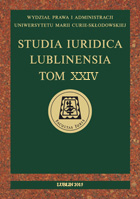Types of Application of Law and the Decision Making Model
Types of Application of Law and the Decision Making Model
Author(s): Leszek LeszczyńskiSubject(s): Law, Constitution, Jurisprudence
Published by: Wydawnictwo Naukowe Uniwersytetu Marii Curie-Sklodowskiej
Keywords: types of application of law; decision-making model; operative interpretation
Summary/Abstract: This article is aimed at associating particular types of application of law, as defined by legal theory, with the decision making model of the process of application of law. Although the model is built on the characteristics of the judicial type of decision making, it also includes important features of other types of decision making processes. The features pertain to, in particular, the subject and the mode of the process as well as decisions, types of control over decisions and decision making discretion. The decision making model is constructed in two versions: the basic version (that ends in making the decision on the consequences of the normative qualification of the facts) and the broad version (encompassing control and enforcement proceedings). Particular components of each version of the decision making model include both validation and reconstruction of the normative basis of the decision on the application of law. These components occur simultaneously and in sequence. Apart from these components, the versions also include establishing the facts, reasoning and the activities of operative interpretation. The versions are subsequently translated into argumentation expressed in the form of justification of the decision to apply law (also a component of the decision making model). Such argumentation is formulated in different styles and refers in different ways to the contents of the decision and to the rationalisation of the process.
Journal: Studia Iuridica Lublinensia
- Issue Year: 24/2015
- Issue No: 2
- Page Range: 27-47
- Page Count: 21
- Language: English

